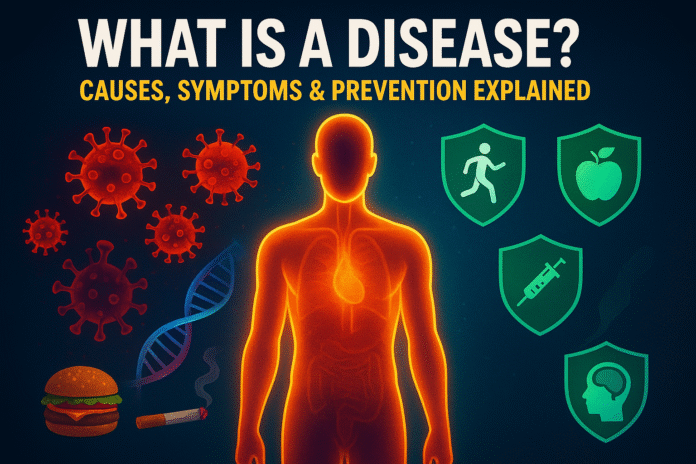A disease is an ailment disrupting the usual balance of the body and mind, prompting health challenges. In less technical terms, a disease is a condition which involves any organ, tissue, or system in the body not functioning as it is supposed to. These may be caused by a multitude of factors such as infection, genetic problems, the environment, lifestyle, or even mental health. For as long as we can remember, the diseases have had an impact on the growth of humanity. For instance, we have all heard of epidemics or even pandemics such as the plague, cholera, Spanish flu and, more recently, COVID. These have had and continue to have significant impacts on populations and societies. On another note, illnesses that we often associate with lifestyle, such as diabetes, cancer and cardiovascular diseases, seem to be emerging silently but rapidly. On the holistic level, diseases are damaging, and they impact not just the body, but mental health, the family, and even work.
Gaining a complete understanding of diseases goes beyond recognizing bodily malfunctions; it includes acknowledging their origins, learning how to detect signs early, and taking proactive measures to safeguard one’s well-being. Through this blog, you will gain a deep understanding of how to recognize health problems, their symptoms, types, and how to prevent them to make well-informed health choices.
Causes of Diseases
Preventing diseases always starts with understanding what causes them. There is always a reason as to why diseases exist, and with knowledge about their causes, one can prevent and treat a disease. Some major causes of diseases can be classified as infectious agents, genetic causes, unhealthy habits, environmental impacts, and psychological concerns. Let us discuss them further.
1. Infectious Agents
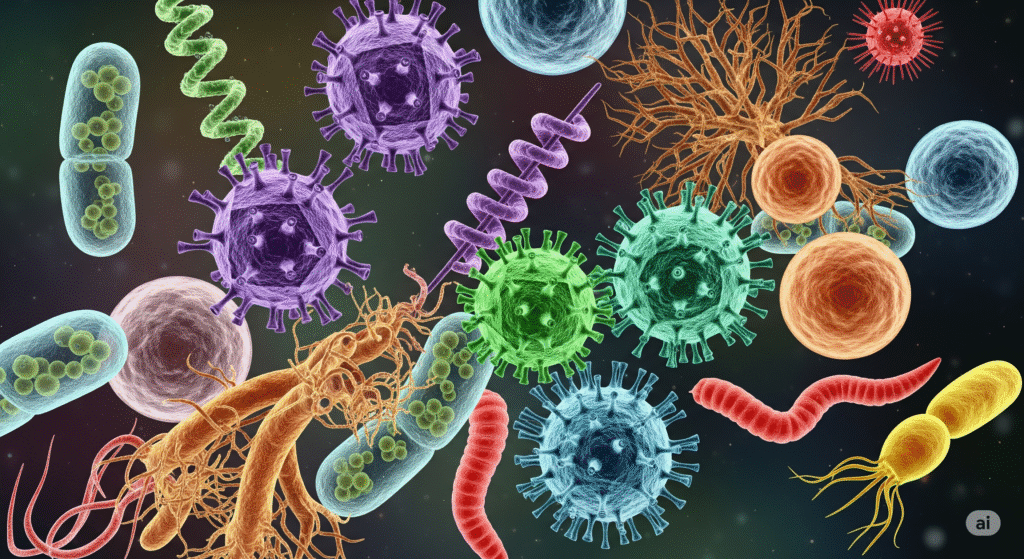
Many diseases stem from infections caused by living organisms, including bacteria, viruses, fungi, and parasites. Infectious diseases pose a risk of transmission from one person to another, whether directly or indirectly. There are a few that can be mentioned, like influenza, that spreads through airborne transmission by sneezing or coughing, malaria that spreads through certain types of mosquito bites, and of course, food poisoning that occurs through the ingestion of contaminated food or water.
Infectious diseases such as HIV/AIDS, Ebola, and even the common cold vary in severity. Due to the cold’s contagious nature, it poses a threat to both the public and the world. An example of this is the COVID-19 pandemic and how its effects were felt globally. The pandemic demonstrated the urgent need for cleanliness, proper sanitization, and timely vaccinations. The cold is often accompanied by poor hygiene and unclean living conditions.
2. Genetic Factors

Infectious diseases such as COVID-19 pose a threat to public and global health. Due to the pandemic, it demonstrated the need for cleanliness, proper sanitization, and timely vaccinations. The cold is often accompanied by poor living conditions. Unlike infectious diseases, genetic disorders cannot be “caught” or “spread.” Instead, they are passed down through DNA. Genetic disorders such as sickle cell anemia and thalassemia are caused by defects in the genes.
Some genetic diseases can be identified while a baby is still in the womb or at the time of birth, and some can be identified in the latter parts of a person’s life. Individuals with a family tree of such disorders are at an elevated risk. Even though many genetic conditions cannot be fully cured, advanced medical research has made it possible to effectively manage many of these conditions. Medications, gene therapy, lifestyle changes, and ongoing health evaluations are some of the potential treatments. One of the best ways to manage and prepare for such hereditary conditions is through early diagnosis using genetic testing and counseling.
3. Lifestyle Factors

Today’s lifestyle choices contribute to the occurrence of non-infectious diseases. Physical inactivity, poor dietary choices, overindulgence in processed foods, insufficient physical activity, smoking, alcohol use, and being chronically stressed leads to diabetes, obesity, heart disease and some cancers.
Unlike the infectious or hereditary diseases, lifestyle-related diseases take years to develop, but once they establish, they become chronic. For instance, eating sugar and fat is highly caloric but not costly in the short term, and hence, it is quite overconsumed. In the long term, obesity transforms the body, leading to increased risk of type 2 diabetes and cardiovascular diseases. The best news to share is that, in most cases, these diseases are preventable. In today’s world, with the increase in fast food and sedentary work culture, lifestyle-related illnesses are one of the biggest threats to public health, along with bad nutrition.
4. Environmental Factors

Health is impacted by the environment one lives in. For example, the prevalence of dirty air and water, harmful chemicals, and unsafe housing can lead to diseases. Residents of cities with excessive air pollution levels experience breathing issues such as asthma, and chronic bronchitis. Moreover, contaminated water sources can lead to cholera, typhoid, and diarrhea. Pesticides, heavy metals, and industrial waste contamination can lead to long-term organ damage or even cancer.
Climate change affects human health directly as well. Increased natural temperatures, for instance, can enhance the spread of existing vector-borne diseases such as malaria and dengue. Natural disasters can also lead to infectious disease outbreaks in the impacted areas. People require a clean atmosphere, uncontaminated water, and proper waste management to live safely and in good health. Governments of the region must focus on eco-friendly policies, and in the meantime, people should plant more trees, restrict plastic use, and turn to clean energy to mitigate danger.
5. Mental Health Issues.

Discussing physical illness often overshadows mental health, but the latter is equally crucial when it comes to a person’s well-being. Physical ailment can directly stem from mental health-related issues like depression and stress. Stress, which is longstanding, can weaken the immune system, increase blood pressure, and elevate chances of heart disease. Fatigue, sleep, and low immunity in the form of increased infections can arise from depression as well.
Mental health concerns can exacerbate existing physical problems, functionality, and resilience. Regrettably, many cultures still regard mental illness as a sign of weakness, leading people to avoid seeking assistance. Nonetheless, counseling, therapy, meditation, exercise, and supportive relationships can greatly enhance mental health. Mental well-being should be taken care of like any other health issue, since both aspects rely on and complement each other.
Types of Diseases
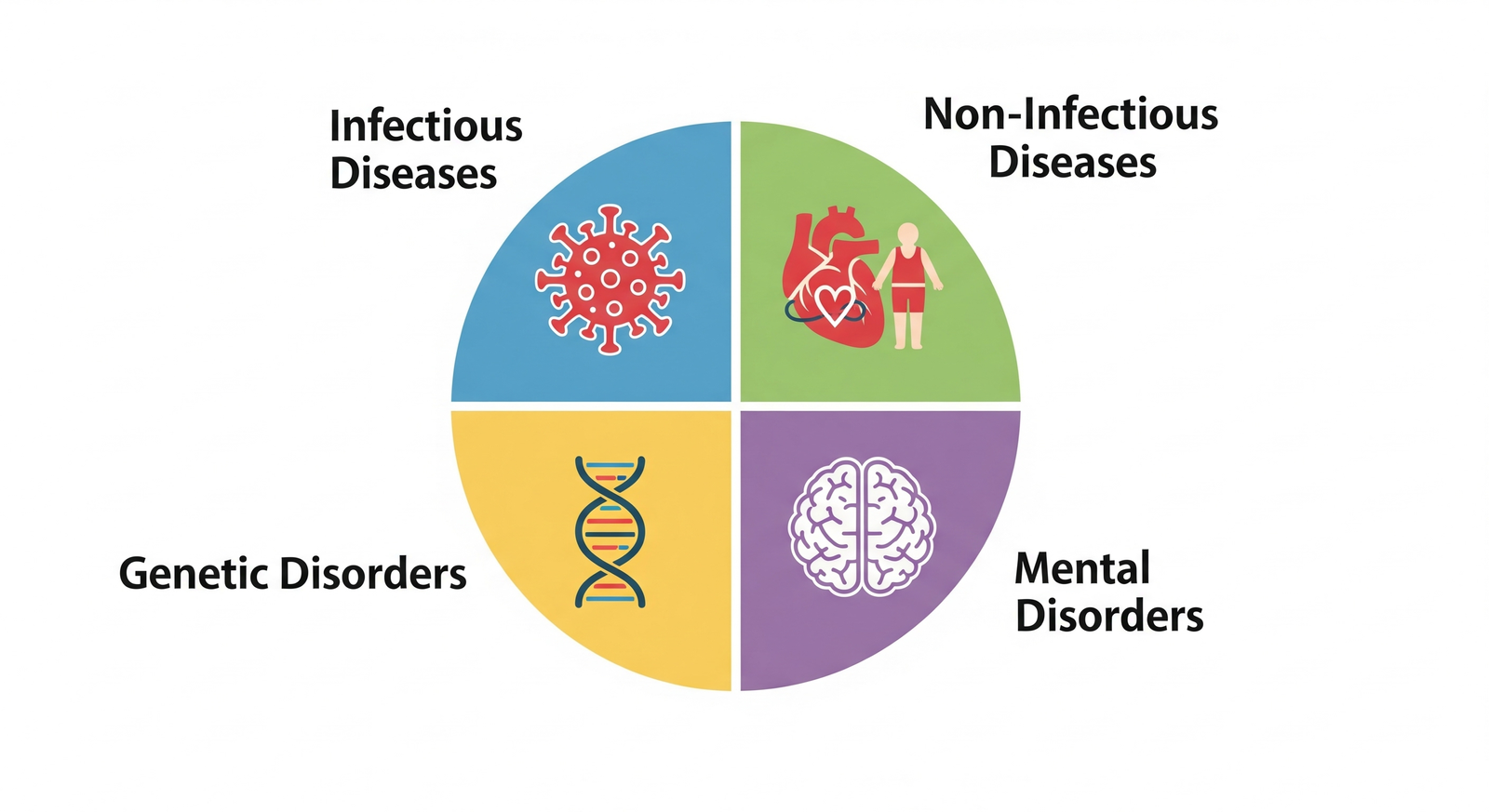
Diseases can be classified into various categories based on their nature, cause, and effect on the body. The four major categories are infectious diseases, non-infectious diseases, genetic disorders, and mental illnesses.
1. Infectious Diseases
These diseases are caused by harmful microorganisms like bacteria, viruses, fungi, and parasites. They can spread through direct contact, air, water, food, or insect bites. Some common examples are influenza, tuberculosis, malaria, cholera, and dengue. Infectious diseases are often preventable with proper hygiene, vaccination, and timely medical intervention.
2. Non-Infectious Diseases
Unlike infectious diseases, non-infectious diseases are not caused by external microorganisms. Instead, they result from internal body dysfunctions or lifestyle habits. Examples include diabetes, hypertension, heart diseases, arthritis, and cancer. These illnesses are usually long-term (chronic) and require regular management rather than a quick cure.
3. Genetic Diseases
Genetic disorders are inherited conditions that are passed from parents to children through genes. Examples include thalassemia, Down syndrome, and sickle cell anemia. While these conditions cannot be entirely prevented, advancements in medical technology have made it possible to manage symptoms effectively and improve the quality of life for affected individuals.
4. Mental Disorders
Mental illnesses affect the brain, thinking, emotions, and behavior. Conditions like depression, anxiety disorders, bipolar disorder, and schizophrenia fall into this category. These diseases may not always show physical symptoms but can deeply affect personal, social, and professional life. With proper counseling, therapy, and sometimes medication, mental illnesses can be managed effectively.
Symptoms of Diseases
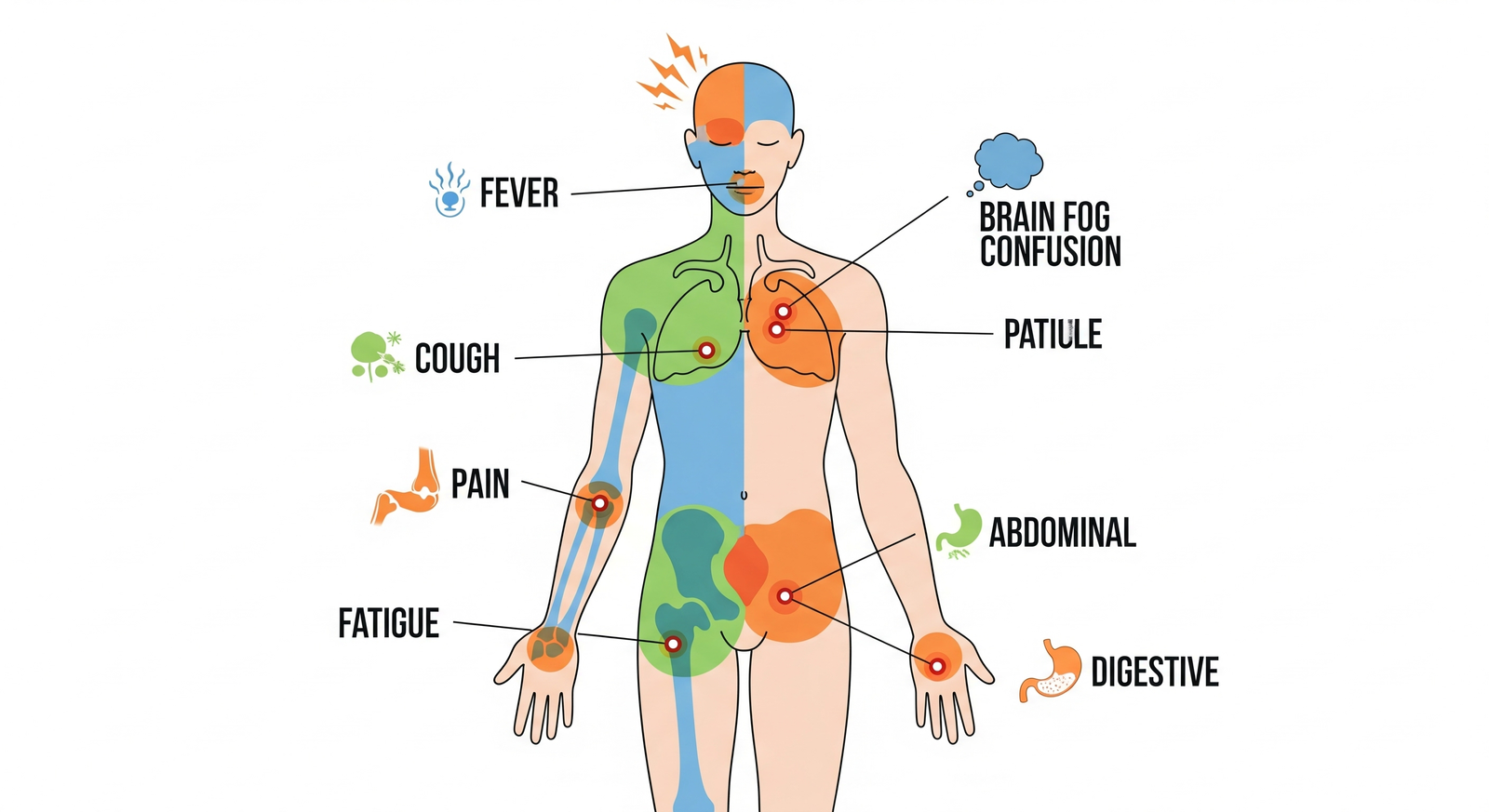
The symptoms of diseases vary depending on their type and severity, but some common signs can help in identifying health issues early.
- Fever and Chills: A common indicator of infections in the body.
- Cough, Cold, and Breathing Problems: Often linked with respiratory infections or allergies.
- Weakness and Fatigue: Can be a sign of both infectious and lifestyle-related illnesses.
- Pain and Inflammation: Localized or general pain may indicate internal issues.
- Digestive Problems: Nausea, vomiting, diarrhea, or loss of appetite are common symptoms of stomach-related diseases.
- Mental Symptoms: Persistent sadness, stress, or loss of concentration may point toward mental health issues.
Recognizing these symptoms at an early stage is crucial. Timely medical advice and treatment can prevent minor health problems from developing into serious conditions.
Prevention of Diseases
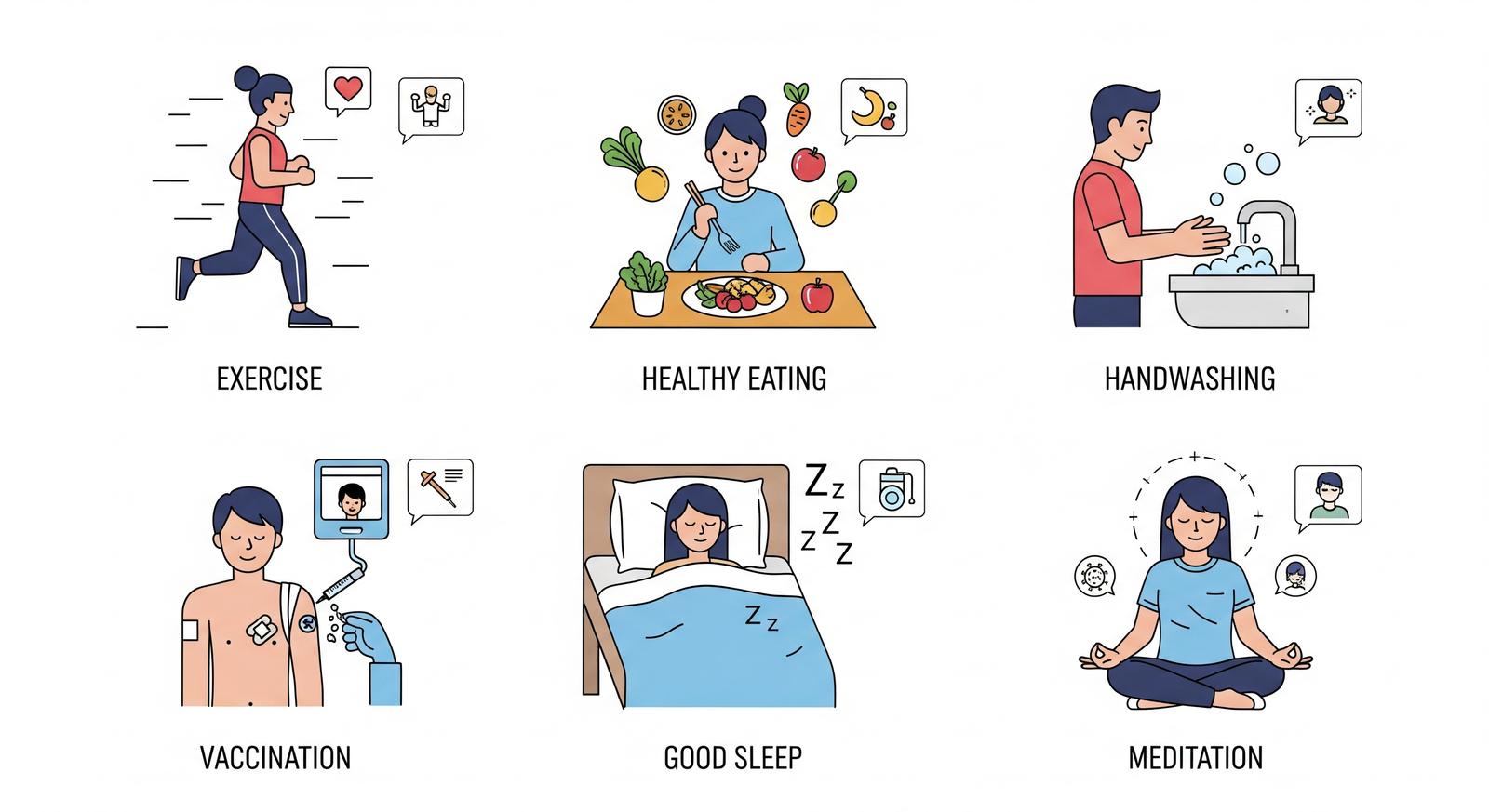
Prevention is always better than cure. By taking simple steps, one can reduce the risk of diseases significantly.
- Maintain Good Hygiene: Wash hands regularly, keep food and water clean, and practice proper sanitation.
- Eat a Balanced Diet: Include fruits, vegetables, whole grains, and proteins in daily meals while avoiding excessive junk food.
- Exercise Regularly: Physical activity strengthens the immune system and reduces the risk of lifestyle diseases.
- Get Vaccinated: Vaccines protect against dangerous infectious diseases like polio, measles, hepatitis, and COVID-19.
- Avoid Harmful Habits: Quit smoking, reduce alcohol consumption, and manage stress effectively.
- Regular Health Checkups: Early detection of health problems through medical tests can save lives.
- Mental Health Care: Practice meditation, mindfulness, and seek counseling if needed.
Most Common Diseases at Present
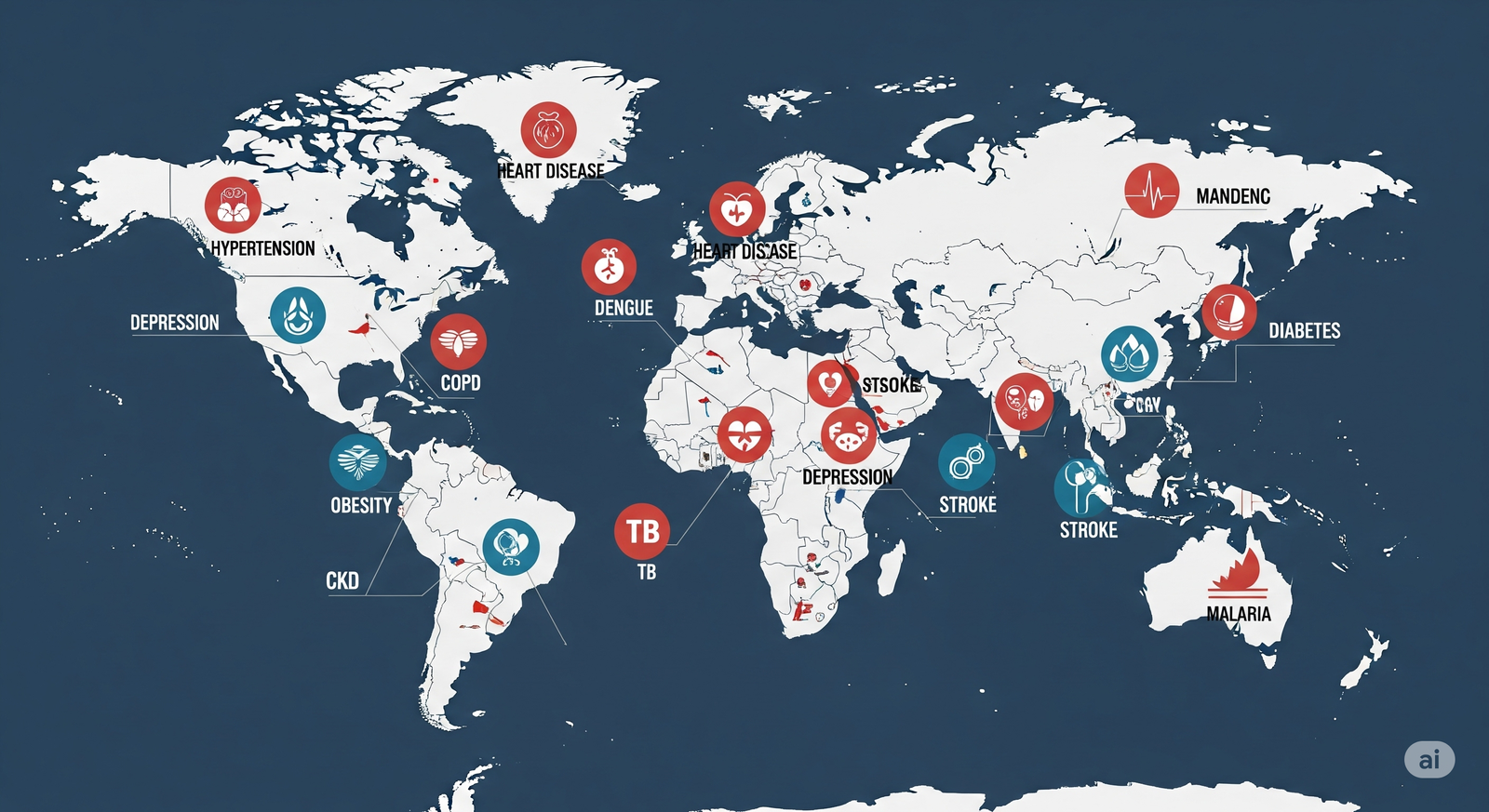
1. Hypertension (High Blood Pressure)
In today’s fast-paced life, high blood pressure has become one of the most common health problems. According to the WHO, around 1.28 billion people aged 30–79 suffer from hypertension, and by 2025, this number may reach 1.5 billion. Hypertension is so dangerous that it accounts for almost half of all deaths from heart diseases and stroke. Major causes include stress, poor diet, lack of physical activity, and unhealthy lifestyle habits.
2. Non-Communicable Diseases (NCDs)
NCDs are now responsible for about 75% of all deaths worldwide. These include heart disease, cancer, diabetes, and chronic respiratory illnesses.
- Diabetes: Around 830 million people are affected globally.
- Cardiovascular Diseases: Leading cause of death in India.
- Cancer: Millions of new cases are diagnosed every year.
3. Respiratory Diseases
Chronic Obstructive Pulmonary Disease (COPD) and stroke-related breathing problems are also becoming more common. In India, respiratory diseases account for around 6% of total deaths. Air pollution, smoking, and poor air quality are major triggers.
4. Dengue
Dengue has now become a global health threat. As per WHO, nearly 3.9 billion people are at risk of dengue infection. Every year, around 39 million cases are reported worldwide. In India, especially in Bihar and northern states, dengue cases are rising rapidly due to climate change and the increasing breeding of mosquitoes.
Future Diseases That May Pose a Threat
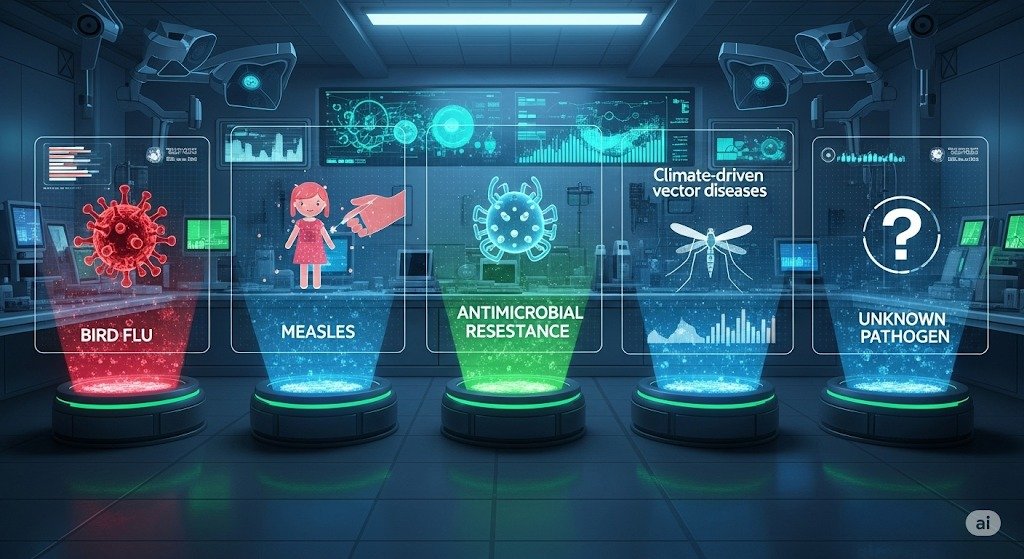
1. Bird Flu (H5N1 Avian Influenza)
Experts warn that if the H5N1 virus mutates and gains the ability to spread easily among humans, it could potentially trigger the next global pandemic. WHO and governments are already preparing to tackle this possible threat.
2. Measles Resurgence
Due to declining vaccination rates, measles cases are rising again. In 2024, the world witnessed the highest number of cases in the last five years. Since measles is highly contagious, it could spread rapidly and turn into a large-scale outbreak.
3. Rising Burden of NCDs
Non-communicable diseases like heart disease, diabetes, and cancer are projected to increase even more in the coming years. This is a serious challenge, especially for developing countries with limited healthcare facilities.
Expanded Summary
| Most Common Diseases (Present) | Future Health Threats |
|---|---|
| 1. Hypertension (High BP) | Bird Flu (H5N1) |
| 2. NCDs – Heart Disease, Cancer, Diabetes | Measles (Resurgence) |
| 3. Respiratory Diseases (COPD, Asthma) | Rising NCD Burden |
| 4. Dengue | Climate-Driven Vector Diseases (like Zika, Chikungunya) |
| 5. Obesity & Metabolic Syndrome | Antimicrobial Resistance (Superbugs) |
| 6. Depression & Mental Health Disorders | New Viral Outbreaks (unknown pathogens, “Disease X”) |
| 7. Tuberculosis (TB) | Multidrug-Resistant TB |
| 8. Chronic Kidney Disease (CKD) | Environmental Pollution-Linked Diseases |
| 9. Stroke & Neurological Disorders | Alzheimer’s & Dementia surge |
| 10. Malaria (still common in many regions) | Future Malaria strains resistant to treatment |
Conclusion

Illnesses are a part of life, but their effects can be lessened with effective action and awareness. Taking the right steps such as understanding the problem deeply, dealing with the issues proactively, and caring physically and emotionally leads to a healthy life. Considering the modern world deeply filled with stress, pollution, and other unwholesome practices makes caring for health absolutely essential. Practicing personal hygiene, dealing with medical issues promptly, and the adoption of basic health standards can help individuals protect their societies from health issues. In the end, health is wealth and the core of joy and productivity, thus, protecting and prioritizing health should be a goal for al.
“Health is the greatest gift, contentment the greatest wealth, and faithfulness the best relationship.”
– Buddha


